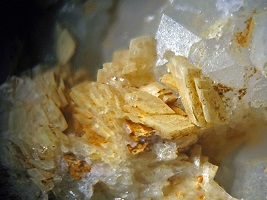
Locality: Johnson Rd. locality, Bow, NH
Specimen Size: 5 mm field of view
Field Collected: Jim Cahoon - 2016
Catalog No.: u2193
Notes: I had this visually identified as dolomite. A June 2018 polished grain EDS analysis (BC290) gave a very good match for dolomite. Carbon is not included in the report due to carbon coating of the polished grain epoxy block.
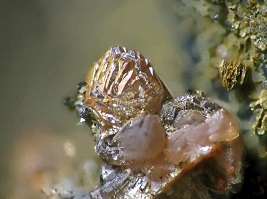
Locality: Government Pit, Albany, NH
Specimen Size: 0.3 mm "pine cone" habit titanite crystal cluster
Field Collected: Leroy Grant - 1970's
Catalog No.: u2235
Notes: A carbon tape mounted grain EDS analysis (BC299) gave a very good match for titanite.
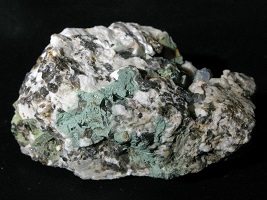
Locality: Government Pit, Albany, NH
Specimen Size: 5 cm specimen with soft blue-green mineral
Field Collected: Leroy Grant - 1970's
Catalog No.: 2094
Notes: A November 2018 carbon tape grain EDS analysis (BC302) gave a result for which glauconite was the "best fit."
Glauconite chemistry is: (K,Na)(Fe+3,Al,Mg)2((Si,Al)4O10)(OH)2 . The chemistry from this EDS analysis gave: K0.24Fe0.34Al2.35Si3O22.8 , normalized for 3 atoms of Si.

Locality: Palermo Mine, N. Groton, NH
Specimen Size: 0.7 mm crystal group
Field Collected: ex. Forrest Fogg ?
Catalog No.: TBC
Notes: The nicest Palermo cerussite I have seen. Some small lumps of green malachite are present on this specimen with cavities of typical Palermo pale tan siderite crystals.
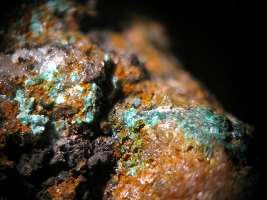
Locality: Palermo Mine, N. Groton, NH
Specimen Size: 12 mm field of view
Field Collected: ex. Forrest Fogg ?
Catalog No.: TBC
Notes: Malachite confirmed by EDS analysis, (BC305). The analysis showed about a 5% zinc content, suggesting some Zn replacement of Cu. Fizz in muriatic acid indicated a carbonate.
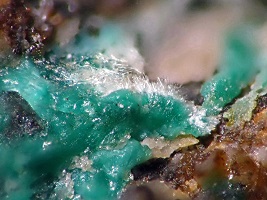
Locality: Palermo Mine, N. Groton, NH
Specimen Size: 1.5 mm field of view. Aurichalcite "fur" on top of malachite.
Field Collected: ex. Forrest Fogg ?
Catalog No.: TBC
Notes: The EDS analysis of the malachite showed about a 5% zinc content, suggesting some Zn replacement of Cu. Therefore, aurichalcite, a zinc-coppper mineral, is a reasonable identification.

Locality: Palermo Mine, N. Groton, NH
Specimen Size: 0.8 mm field of view.
Field Collected: ex. Forrest Fogg ?
Catalog No.: TBC
Notes: The EDS analysis of the malachite on another specimen area showed about a 5% zinc content, so zinc is present in the vacinity of these tiny crystals. These crystals are very lusterous, much more than other Palermo carbonates.
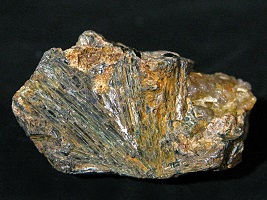
Locality: Franconia, NH
Specimen Size: 2.4 cm specimen
Field Collected: Joey Vaughan
Catalog No.: 2099
Notes: Identification by comparison to other Franconia, NH magnesiogedrite specimens.
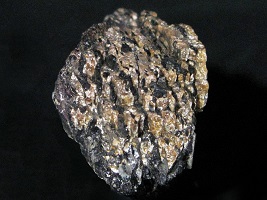
Locality: Fletcher Mine, N. Groton, NH
Specimen Size: 2.2 cm high specimen
Field Collected: Clayton Ford via Gordon Jackson
Catalog No.: 2101
Notes: My first guess at this cream colored mineral was lithiophilite.
EDS analysis, (BC174 - set 13) indicated a chemistry of (Fe0.77,Mn0.65,Ca0.73)P2O10.5 , normalized for two atoms of P. I forwarded photo and EDS results to Jim Nizamoff and he opined graftonite. Chemically graftonite, (Fe2+,Mn2+,Ca)3(PO4)2 , is a good fit.
The dark mineral between the layers of graftonite is heterosite-purpurite.

Locality: Joppa Hill, Amherst, NH
Specimen Size: 5 mm field of view
Field Collected: Tom Mortimer - 2009
Catalog No.: 1363
Notes: A carbon tape mounted grain EDS analysis (BC257) gave a good match for covellite. The oxygen response is likely due to some surface oxidation of the carbon tape grain.
This specimen came from a large quartz outcrop about 100 yards below the classic Joppa Hill skarn collecting area.
Some residual chalcopyrite is also present in this small vug.
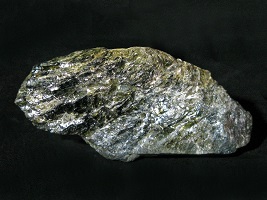
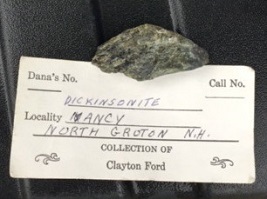
Locality: Nancy Mine, N. Groton, NH
Specimen Size: 3.3 cm specimen of lustrous, glassy dark olive green, arrojadite
Field Collected: Clayton Ford - Label photo included.
Catalog No.: 2102
Notes: My card table of NH minerals at the 2018 Gilsum Rock Swap attracted the attention of Ken Leger of Milford, NH. Ken said he had acquired a small batch/collection of minerals (at a yard sale for $10.). He asked if I would take a look at them. I followed him back to his tailgate and he produced a small box of poly-bagged specimens. One bag had several glassy olive green specimens from the Nancy Mine with an accompanying Clayton Ford (1917-2001) label. Dickinsonite ! Phillip Morrill's New Hampshire Mines and Mineral Localities booklet (1960) lists dickinsonite for the Nancy Mine, (source likely M. Mrose). The arrojadite group (included dickinsonite) was expanded and re-defined in two American Mineralogist articles in 2006, many years after Morrill's booklet and Clayton's field collecting, so it is understandable how this got labeled as dickinsonite.
A polished grain EDS analysis (BC306) suggests this specimen is arrojadeite-(KNa) or arrojadite-(KFe).
The chemistry calculated from the atomic percents of this EDS analysis gives: K0.59Na2.01Fe7.26Mn1.77Ca1.37Mg0.46Al0.31P12O8.73 , normalized for 12 P. All the elements are present for an arrojadite group species, but the element ratios do not fit particularly well.
There are 15 (IMA approved) members of arrojadite group. For reference:
Dickinsonite: {KNa}{Mn2+[ ]}{Ca}{Na3}{Mn2+13}{Al}(PO4)12(OH)2
Arrojadite-(KNa): {KNa}{Na2}{Ca}{Na2[ ]}{Fe2+13}{Al}(PO4)11(HPO4)(OH)2
Arrojadite-(KFe): {KNa}{Fe2+[ ]}{Ca}{Na2[ ]}{Fe2+13}{Al}(PO4)11(HPO4)(OH)2
The "[ ]" vacancy slots may be filled by one or two monovalent cations (K, Na).
It is interesting that only one arrojadeite group member has any Mg as essential, fluorcarmoite-(BaNa). My specimen analysis had a moderate amount of Mg, but no Ba.
It is very satisfying to have acquired this specimen from the original NH "dickinsonite" occurrence. The Nancy Mine has been "off limits" for many years.
My NH display arrojadite is also from the Nancy Mine. It is much lighter green than this specimen. Its NH display arrojadite EDS analysis showed a moderate barium content suggesting arrojadite-(BaFe). An analysis with quantitative atomic percents would be informative for this specimen.
Postscript: A New Hampshire dickinsonite has been a sought after species by several fellow collectors for many years. It is most likely that dickinsonite, as now redefined by the IMA, does not exist in NH. Bob Wilken stated "trying to nail down a specific arrojadite seems to be next to impossible with EDS. I'm just happy if I can get in the "ballpark."